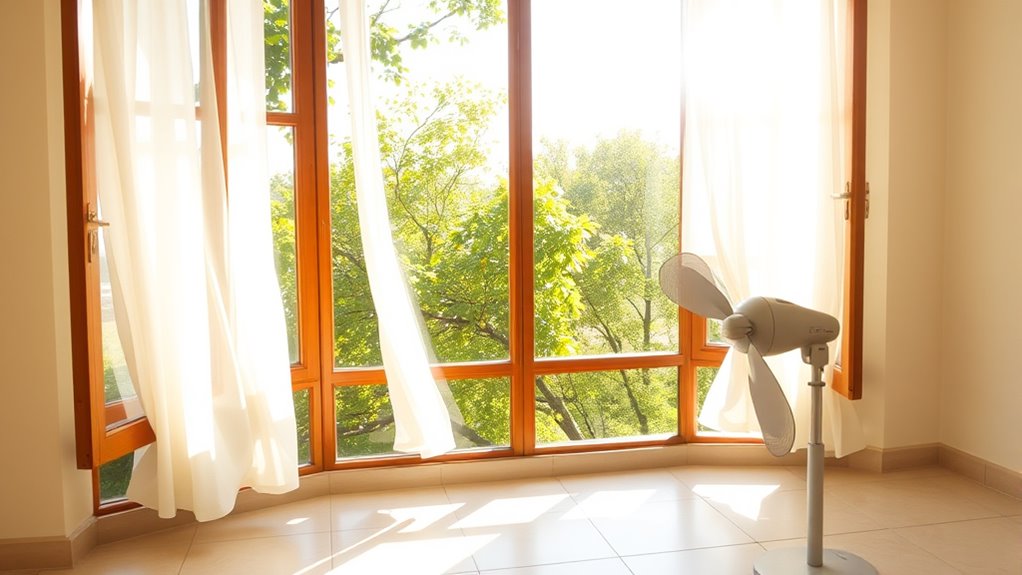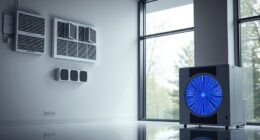To enhance natural ventilation, open windows on opposite sides of your space to create cross-breezes, allowing fresh outdoor air to flow through. Use fans, such as ceiling or portable units, to boost airflow and help expel stale air. Timing your window and fan use during cooler parts of the day maximizes comfort and energy savings. With strategic placement and operation, you can enjoy improved indoor air quality and comfort—keep exploring for more effective ventilation tips.
Key Takeaways
- Open windows on opposite sides of a room to create cross-breezes that enhance airflow and ventilation.
- Use fans to draw in fresh outdoor air and expel indoor stale air, boosting natural ventilation efficiency.
- Timing window openings during cooler parts of the day, like mornings and evenings, optimizes temperature regulation.
- Position fans at higher points to push warm, stale air out and promote continuous indoor airflow.
- Combine strategic window placement with fan use to maximize natural ventilation and improve indoor air quality.

Natural ventilation techniques harness the movement of outdoor air to cool and refresh indoor spaces without relying on mechanical systems. When you open windows or use fans strategically, you’re actively improving indoor air quality by letting fresh air circulate, diluting indoor pollutants, and reducing stuffiness. This approach not only creates a healthier environment but also helps you save on energy costs by minimizing the need for air conditioning or mechanical ventilation.
Harness outdoor air to refresh indoor spaces, improve air quality, and save energy naturally.
By opening windows at opposite ends of a room or building, you create a cross-breeze that enhances airflow and keeps indoor spaces feeling more comfortable. The increased air exchange reduces indoor pollutants like dust, allergens, and volatile organic compounds, which can accumulate indoors over time. As a result, you enjoy clearer air, fewer respiratory irritants, and a more inviting environment. This natural method supports better indoor air quality without the use of filters or air purifiers, making it a simple yet effective solution.
Using fans complements this process. When you position a fan near an open window, it pulls in fresh outdoor air and pushes stale indoor air out. Ceiling fans or portable fans can be adjusted to boost airflow during warmer days, helping to maintain a consistent indoor temperature and reducing the burden on your cooling systems. This not only makes your space more comfortable but also boosts energy efficiency, as fans consume considerably less electricity than air conditioning units. By relying on fans, you conserve energy while enhancing ventilation, which is especially useful during mild weather or in transitional seasons.
Timing your ventilation efforts can make a big difference. Opening windows early in the morning or late in the evening, when outdoor temperatures are cooler, maximizes energy efficiency. During peak heat, keeping windows closed and using fans to circulate indoor air can prevent heat from entering, helping maintain a cooler indoor environment without cranking up the AC. This practice reduces your overall energy consumption and lowers utility bills.
In addition, the placement of windows and fans matters. Positioning windows on different sides of your home encourages cross-ventilation, creating a steady flow of fresh air. Using fans to direct airflow from higher to lower points can also help remove warm, stale air and bring in cooler outdoor air. This natural movement of air keeps your indoor space fresh, reduces reliance on mechanical cooling, and promotes a healthier, more energy-efficient home environment. Overall, these simple techniques empower you to control indoor air quality and energy use effectively, making your living space more comfortable and eco-friendly.
Frequently Asked Questions
How Does Outdoor Air Quality Affect Natural Ventilation Effectiveness?
Outdoor air quality directly impacts natural ventilation effectiveness because poor air quality, like high air pollution, can introduce harmful pollutants into your indoor space. When you open windows, allergens and pollutants may infiltrate, reducing indoor air quality and potentially causing health issues. Using fans can help improve airflow but won’t filter out pollutants, so it’s essential to take outdoor conditions into account before ventilating to make certain you’re not bringing in harmful particles.
Can Natural Ventilation Control Indoor Humidity Levels Properly?
Imagine a home in a humid climate where you open the windows daily. Natural ventilation can help with humidity management, but it often falls short of providing precise moisture control. While it can reduce indoor humidity temporarily, it doesn’t consistently maintain ideal levels, especially during rainy or very humid days. For effective moisture control, you might need additional measures like dehumidifiers alongside natural ventilation to manage indoor humidity levels properly.
What Are the Best Times of Day to Maximize Airflow?
To maximize airflow, you should focus on timing strategies that align with outdoor conditions. The best times are early mornings and late evenings when the outside air is cooler and less humid, promoting airflow optimization. During these periods, open windows on opposite sides of your space to create a cross breeze. Avoid midday when temperatures rise, and outdoor air becomes less effective at ventilating your indoor space.
How Do Building Design and Orientation Impact Ventilation Efficiency?
Did you know that building design and orientation can improve airflow by up to 50%? Your building layout and architectural features markedly influence ventilation efficiency. By aligning windows and openings with prevailing winds, you maximize natural airflow. Thoughtful orientation reduces reliance on mechanical cooling, improves indoor air quality, and enhances comfort. Incorporate features like vents and strategically placed openings to optimize airflow regardless of external conditions, making your space healthier and more energy-efficient.
Are There Safety Concerns With Leaving Windows Open Overnight?
Yes, leaving windows open overnight can pose security risks and pest intrusion. Thieves might take advantage of open windows, so guarantee they’re secure or locked. Additionally, pests like insects or rodents could enter your home through open windows, especially if screens aren’t in place. To balance ventilation and safety, consider installing secure screens, using window locks, or opening windows during daytime hours and closing them at night.
Conclusion
Think of natural ventilation as your home’s invigorating gust. By opening windows and using fans wisely, you create a gentle breeze that refreshes every corner. It’s like giving your space a heartbeat—pumping out stale air and inviting in new vitality. With these simple techniques, you’re not just improving airflow; you’re transforming your home into a lively, breathing sanctuary. So, take the reins and let the natural breeze guide your comfort.









